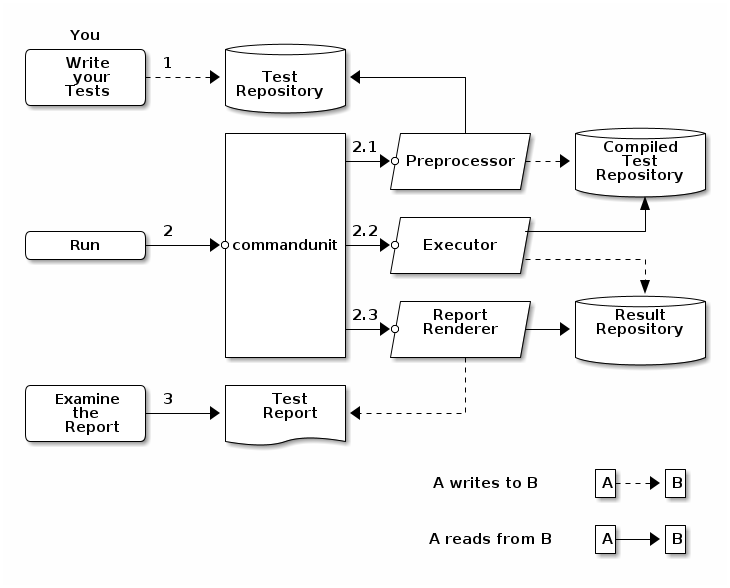Command Line Options
Following is the description of command line options of commandunit.
$ commandunit --help
Usage: commandunit [WRAPPER OPTION]... [--] [OPTION]... [SUBCOMMAND]...
A wrapper function for 'commandunit' to invoke its docker image.
Followings are switching options to control the wrapper's behaviour.
Options not listed here or ones after the separator (--) are passed to the docker image directly.
Wrapper options: (1)
--native Use the 'native' version of commandunit. (2)
--version={VERSION} Use the specified version of commandunit. If 'snapshot' is given, a version under development is used (default: v1.24).
--debug-shell Get the shell of the docker image. Type Ctrl-D to quit it. Development purpose only.
(3)
--show-image-name Print the image name. Useful to figure out the version.
--quit Quit before running the image. With --show-image-name, useful to figure out the image version
--help Show this help and pass the --help option to the docker image.
-- A separator to let this wrapper know the options after it should be passed directly to the image
Usage: commandunit [OPTION]... [SUBCOMMAND]...
Runs tests.
Sub-commands: (4)
preprocess:
Preprocesses test definition files (yaml++, yaml, and json++) and convert them into executable JSON test files
run:
Runs tests under a directory specified by --test-workdir and writes a report file: testreport.json under a
directory specified by --test-reportdir.
report:
Reads a file testreport.json under directory specified by --test-reportdir and renders a report file (testreport.adoc)
under the same directory.
none:
Does nothing.
Options: (* - for development use only)
-h, --help show this help
-p, --parallel execute the tests in parallel
-f, --filter filter tests with the specified regular expression(default:'.*')
--commandunit-dir directory to store config and data files (default: {test-srcdir}/.commandunit)
--project-name set project name of the test execution. used as the report's title(default:'unknown')
--test-srcdir specify directory under which tests are stored (default: current directory/src/test)
--test-workdir specify directory under which commandunit writes internal data* (default: current directory + /target/commandunit/work)
--test-reportdir write test reports under the specified directory* (default: current directory + /target/commandunit/report)
--ignore-mtime ignore mtime and forcibly compile tests (5)
--clean clean working directory
--tapview show test progress with 'tapview'
Examples:
commandunit Run tests found under current directory in sequential mode.
commandunit --test-srcdir=DIR Run tests found under DIR in sequential mode.
commandunit --test-srcdir=DIR -p Run tests found under DIR in parallel mode.
- Test Anything Protocol: <https://testanything.org/>
- documentation: <https://dakusui.github.io/commandunit/>
- github project: <https://github.com/dakusui/bud>
- tapview: <https://gitlab.com/esr/tapview>
-
<1>: Check Wrapper Options and Normal Options section for more detail.
-
<2>: "native" mode means an execution mode of
commandunit, where it is executed without using docker. Check "Native" execution for more Detail. -
<3>: This option gives you a shell inside the docker image of
commandunit. Values environment variables are guaranteed to be the same as the ones, when you execute it without this position. -
<4>: Check Sub-commands section for more detail.
-
<5>: Forcibly
commandunitpreprocesses the test source files and intermediate files.
Wrapper Options and Normal Options
As described in the Design Detail, commandunit comes with its "wrapper" script.
The wrapper has its own options, and it interprets command line arguments as wrapper options, first.
If -- is present and any non-valid wrapper option is found before it, an error will be reported and commandunit will quit with non-0 exit code.
The arguments that cannot be interpreted as wrapper options will be passed to the commandunit 's main part.
The main part parses them as "normal" options using getopt.
"Native" execution
It is possible to use commandunit without Docker solutions.
The mode is called "native" mode, although it is executed as a bash script, not a binary executable.
To execute commandunit in native mode, you can just give --native wrapper option to its command line.
Sub-commands

commandunitAs described in the Command Line Options, commandunit has four subcommands, which are:
-
preprocess -
execute -
report -
none
preprocess, execute, and report correspond to the actions 2.1, 2.2, and 2.3 respectively in the diagram:The Processing Pipeline of the commandunit,
none does nothing, and it is useful to use in combination with --clean option, which removes all the generated files in the project.
$ commandunit --clean none